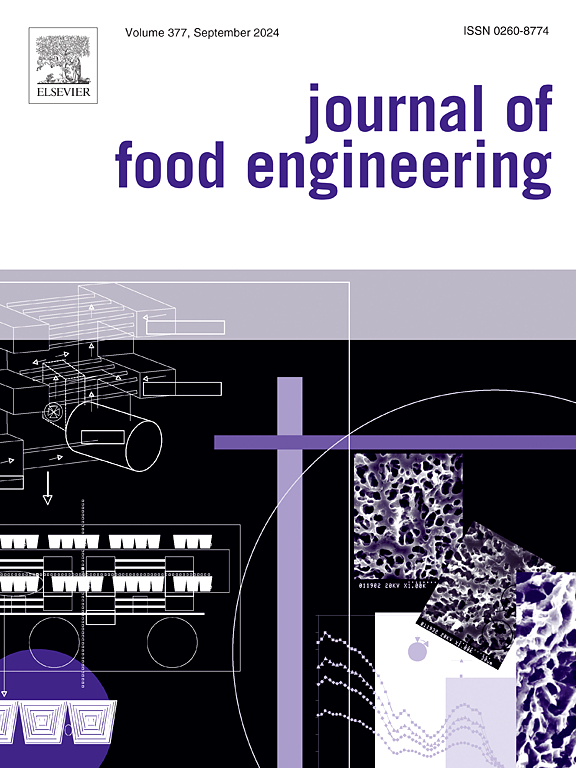Studying the effects of superchilling storage conditions on the microstructure and quality of chicken breast meat
IF 5.3
2区 农林科学
Q1 ENGINEERING, CHEMICAL
引用次数: 0
Abstract
This work aims to investigate the impact of superchilling conditions on the microstructure and quality of chicken breast meat. The chicken breast samples were partially frozen in an air blast freezer at −30 °C for 1 min and 10 min for microstructure and quality analyses, respectively, followed by storage under three different conditions (‒ 1.3 ± 0.5 °C; −1.6 ± 0.1 °C; ‒ 2.0 ± 0.1 °C) for 21 days. X-Ray microtomography coupled with a thermostated cell was used to image and quantify the evolution of the 3D microstructure throughout the storage period at four different analysis time-points (1, 7, 15, 21 days). Quality attributes such as drip loss, color, and pH was also assessed at the same analysis time-points. This novel approach provided detailed insights into the ice crystal location, distribution, and volume fraction within the samples. Results showed that the microstructure and quality were significantly impacted by storage conditions, with more pronounced changes observed under fluctuating temperature (‒ 1.3 ± 0.5 °C). Notably, ice volume fraction increased from 30% to approximately 37% in constant storage conditions, while fluctuating temperatures led to a decrease in ice volume fraction to around 26%. Drip loss remained stable the first fifteen days of storage before increasing by around 20% for constant temperatures but increased by 64% under fluctuating conditions by day 21. Color difference and pH evolution were also influenced by storage duration and temperature. A principal component analysis showed that drip loss and meat discoloration were strongly correlated to prolonged storage while the evolution of pH and ice volume fraction depended primarily on the specific superchilling temperatures applied. These findings emphasize the importance of precise temperature control during superchilling to maintain meat quality.
The novelty of this work lies in the application of X-ray microtomography to assess the impact of superchilling conditions on meat structure, providing a detailed insight into microstructural changes. This method offers a unique, non-destructive way to monitor quality attributes, offering valuable information for optimizing the design of the superchilling process and ensuring product quality.
研究超低温贮藏条件对鸡胸肉显微结构和品质的影响
本研究旨在探讨过冷条件对鸡胸肉微观结构和品质的影响。鸡胸肉样品在- 30°C的冷冻室中部分冷冻1 min和10 min,分别进行微观结构和质量分析,然后在三种不同条件下(- 1.3±0.5°C;−1.6±0.1℃;- 2.0±0.1°C)保存21天。x射线显微断层扫描与恒温池结合使用,在四个不同的分析时间点(1、7、15、21天)对整个储存期间的3D微观结构的演变进行了成像和量化。质量属性,如滴漏损失,颜色和pH值也在相同的分析时间点进行评估。这种新颖的方法提供了对样品中冰晶位置、分布和体积分数的详细见解。结果表明,贮藏条件对其显微组织和质量有显著影响,其中温度波动(- 1.3±0.5°C)下的变化更为明显。值得注意的是,在恒定储存条件下,冰体积分数从30%增加到约37%,而温度波动导致冰体积分数下降到26%左右。前15天滴漏量保持稳定,在恒温条件下滴漏量增加约20%,但在波动条件下,到第21天滴漏量增加64%。贮藏时间和温度对颜色差异和pH变化也有影响。主成分分析表明,滴漏损失和肉变色与长时间储存密切相关,而pH值和冰体积分数的变化主要取决于所施加的特定过冷温度。这些发现强调了在超冷过程中精确控制温度以保持肉品质的重要性。这项工作的新颖之处在于应用x射线显微断层扫描来评估超冷条件对肉类结构的影响,提供了对微观结构变化的详细了解。这种方法提供了一种独特的、非破坏性的方法来监测质量属性,为优化超冷过程的设计和确保产品质量提供了有价值的信息。
本文章由计算机程序翻译,如有差异,请以英文原文为准。
求助全文
约1分钟内获得全文
求助全文
来源期刊

Journal of Food Engineering
工程技术-工程:化工
CiteScore
11.80
自引率
5.50%
发文量
275
审稿时长
24 days
期刊介绍:
The journal publishes original research and review papers on any subject at the interface between food and engineering, particularly those of relevance to industry, including:
Engineering properties of foods, food physics and physical chemistry; processing, measurement, control, packaging, storage and distribution; engineering aspects of the design and production of novel foods and of food service and catering; design and operation of food processes, plant and equipment; economics of food engineering, including the economics of alternative processes.
Accounts of food engineering achievements are of particular value.
 求助内容:
求助内容: 应助结果提醒方式:
应助结果提醒方式:


